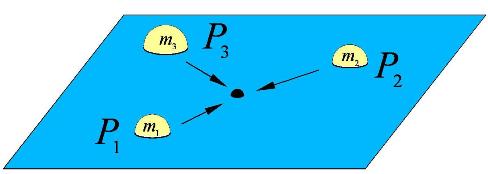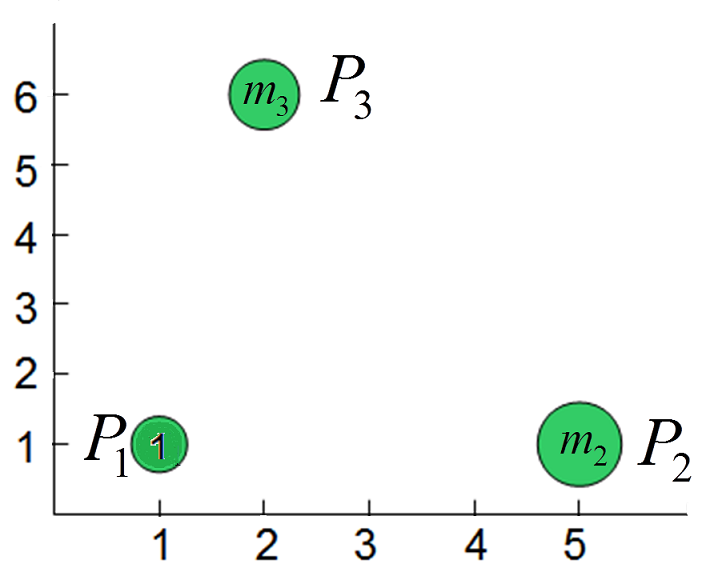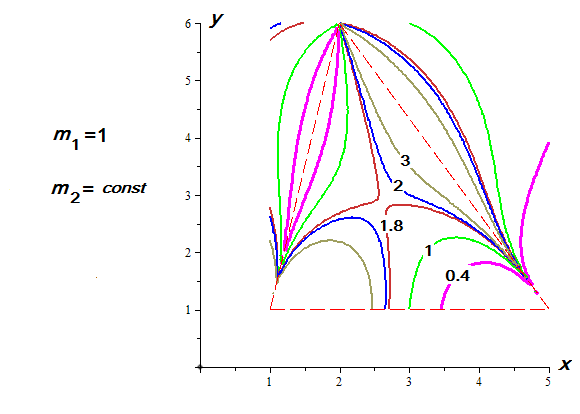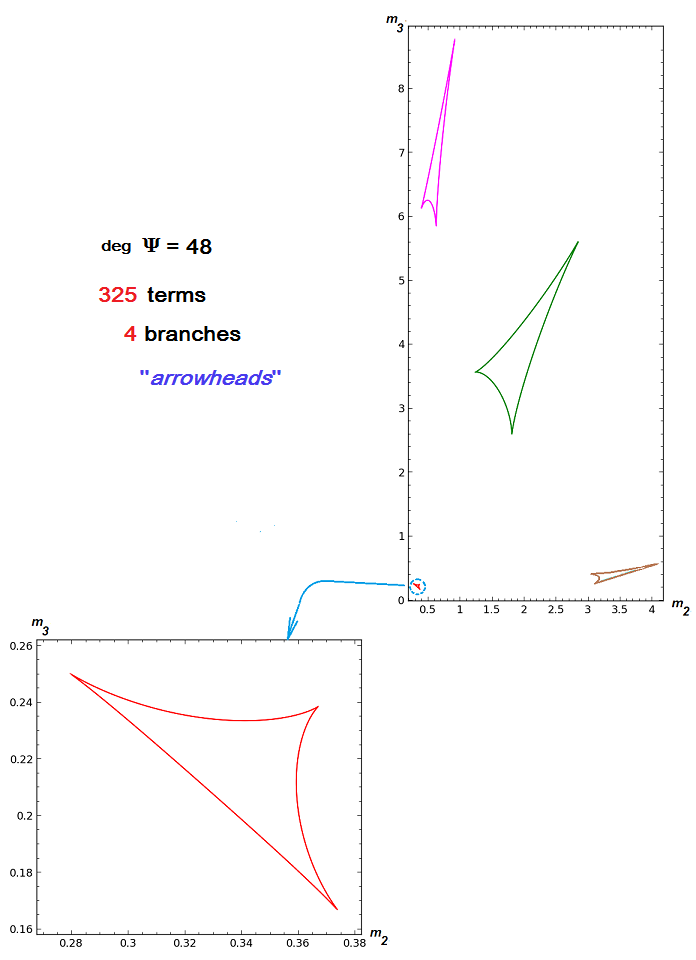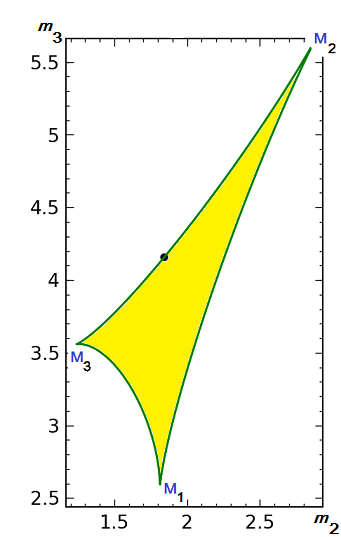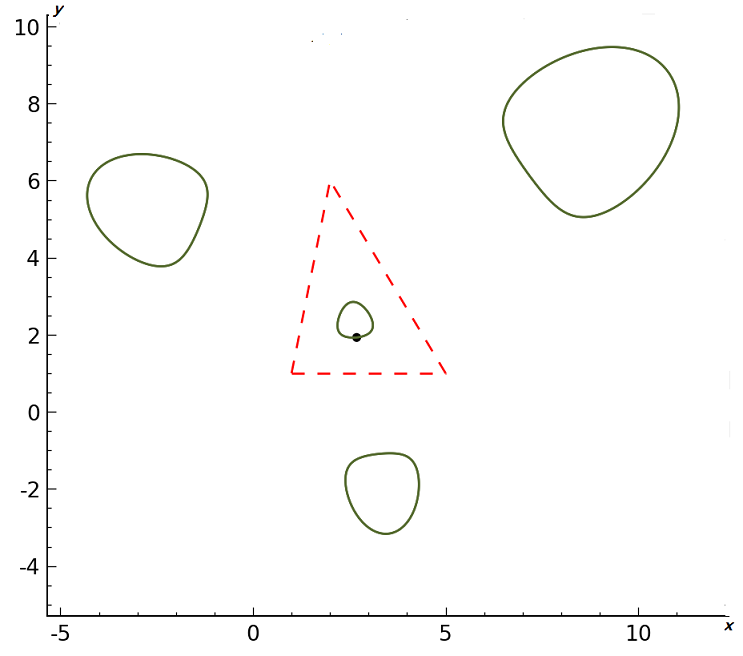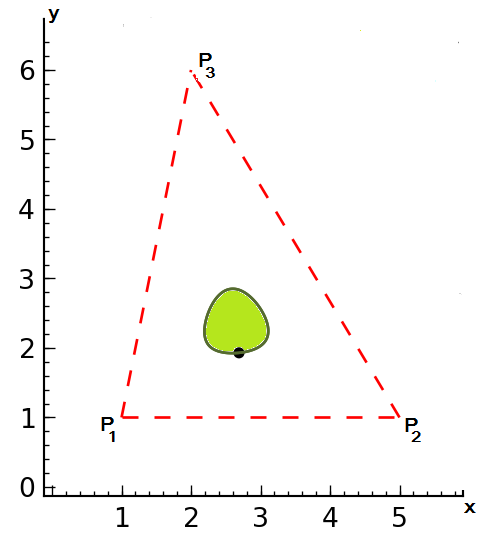Основное
Содержание
ICCTPEA-2014, St.Petersburg
On the Stationary Points
of Coulomb’s Potential Generated by Point Charges
Alexei Uteshev
St.Peterburg State University
Problem
Point charges: equilibrium positions for $$ F(P)=\frac{m_1}{|PP_1|}+\dots+ \frac{m_K}{|PP_K|} $$ Coulomb's or Newton's potentials
$$ \{P_1,\dots,P_K\} \subset \mathbb R^n,\ \{m_1,\dots,m_K\} \subset \mathbb R $$
$$ | \cdot | - \mbox{ Euclidean metrics } $$
Maxwell's conjecture: The number of stationary points $ \le (K-1)^2 $. [Not proved].
Difficulties
Coulomb's potential : $ n=2,\ K= 3 $; stationary points
$$ F(P)=\frac{m_1}{|PP_1|}+\frac{m_2}{|PP_2|}+\frac{m_3}{|PP_3|} $$
Gradient systems $$ \frac{D\, F}{D\, P} = \mathbb O $$
Reduction to an algebraic system
$$
\begin{array}{c}
\left\{\begin{array}{l}
\displaystyle \frac{m_1(x-x_1)}{\sqrt{(x-x_1)^2+(y-y_1)^2}^3}+ \frac{m_2(x-x_2)}{\sqrt{(x-x_2)^2+(y-y_2)^2}^3}+ \frac{m_3(x-x_3)}{\sqrt{(x-x_3)^2+(y-y_3)^2}^3} = 0, \\
\\
\\
\displaystyle \frac{m_1(y-y_1)}{\sqrt{(x-x_1)^2+(y-y_1)^2}^3}+ \frac{m_2(y-y_2)}{\sqrt{(x-x_2)^2+(y-y_2)^2}^3}+ \frac{m_3(y-y_3)}{\sqrt{(x-x_3)^2+(y-y_3)^2}^3} = 0
\end{array} \right. \\
\Downarrow \\
{\rm Squaring \ procedure} \\
\Downarrow \\
\left\{
\begin{array}{ll}
F_1(x,y,m_1,m_2, m_3) = 0, \\
F_2(x,y,m_1, m_2,m_3) = 0,
\end{array}
\right. \deg_{[x,y]} F_j = 28 \\
\Downarrow \\
{\rm Elimination \ of \ variable} \\
\Downarrow \\
\ldots
\end{array}
$$
T
![]()
![]() hard
!!!
hard
!!!
Bypass
Inverse problem : Given $$ P_1,\dots,P_{n+1} , P_{\ast} \subset \mathbb R^{n} $$ find $ \{m_1,\dots,m_{n+1}\} $ for $ P_{\ast} $ to be a stationary point for $$ F(P)=\sum_{j=1}^{n+1} m_j |PP_j|^{-1} $$
Essential: Number of points $ = 1+ \dim $: $$ K=n+1 \ . $$
n=2
$$ \{ m_j^{\ast} = |P_{\ast}P_j|^{3} S_j \}_{j=1}^3 $$
$$ S_1=\left| \begin{array}{ccc} 1 & 1 & 1 \\ x_{\ast} & x_2 & x_3 \\ y_{\ast} & y_2 & y_3 \end{array} \right|,\ S_2= \left| \begin{array}{ccc} 1 & 1 & 1 \\ x_1 & x_{\ast} & x_3 \\ y_1 & y_{\ast} & y_3 \end{array} \right|,\ S_3 = \left| \begin{array}{ccc} 1 & 1 & 1 \\ x_1 & x_2 & x_{\ast} \\ y_1 & y_2 & y_{\ast} \end{array} \right| $$
$ P_{\ast}=(x_{\ast},y_{\ast}) $ is a stationary point for $ F(P)=m_1^{\ast}|PP_1|^{-1} +m_2^{\ast}|PP_2|^{-1} +m_3^{\ast}|PP_3|^{-1} $.
$$ \left\{ \begin{array}{ccc} m_1|PP_1|^{-3} (x-x_1)+m_2|PP_2|^{-3} (x-x_2)+m_3|PP_3|^{-3} (x-x_3)&=&0, \\ m_1|PP_1|^{-3} (y-y_1)+m_2|PP_2|^{-3} (y-y_2)+m_3|PP_3|^{-3} (y-y_3)&=&0. \\ \end{array} \right. $$
Linear system w.r.t. $ m_1,m_2,m_3 $
$$ m_1:m_2:m_3= |PP_1|^{3} S_1(x,y) : |PP_2|^{3} S_2(x,y) : |PP_3|^{3} S_3(x,y) $$
$$
\left[\frac{m_2S_1}{m_1S_2} \right]^2= \left[\frac{|PP_2|}{|PP_1|}\right]^{6},\ \left[\frac{m_2S_3}{m_3S_2} \right]^2= \left[\frac{|PP_2|}{|PP_3|} \right]^{6} \ .
$$
Coulomb 3 charges: bifurcation picture
$$ F(x,y)=\frac{1}{\sqrt{(x-1)^2+(y-1)^2}}+ \frac{m_2}{\sqrt{(x-5)^2+(y-1)^2}}+\frac{m_3}{\sqrt{(x-2)^2+(y-6)^2}} $$
$$ \begin{array}{c} \widetilde F_1(x,y,m_2,m_3)= \\ =m_2^2\,(5\,x+3\,y-28)^2(x^2+y^2-2\,x-2\,y+2)^3 -(5\,x-y-4)^2(x^2+y^2-10\,x-2\,y+26)^3 , \\ \widetilde F_2(x,y,m_2,m_3)= \\ =m_2^2\,(4\,y-4)^2(x^2+y^2-4\,x-12\,y+40)^3 -m_3^2\,(5\,x-y-4)^2(x^2+y^2-10\,x-2\,y+26)^3. \end{array} $$
Find the locus of stationary point for any $ m_2, m_3 $:
$$ \widetilde F_1(x,y,m_2) = 0 $$
$$ \mathbf{Resultant}_x (\widetilde F_1, \widetilde F_2)\equiv (y-1)^8(y-6)^4 \mathcal Y(y,m_2,m_3), \ \deg_y \mathcal Y =34 \ . $$
2 vs. 4 stationary point
$$ \mathbf{Discriminant}_y( \mathcal Y(y,m_2,m_3)) \equiv \Xi^2(m_2,m_3) \Psi(m_2,m_3) \quad , \quad \deg \Xi=444, \deg \Psi =48 $$
$$ \Psi(m_2,m_3)= $$ $$ =3^{36}(169\,m_2^2+192\,m_2m_3+64\,m_3^2)^5(169\,m_2^2 -192\,m_2m_3+64\,m_3^2)^5(28561\,m_2^4+19968\,m_2^2m_3^2+4096\,m_3^4)^7 $$ $$ + \dots + $$ $$ + 2^2\cdot 3^{31} \cdot 17^{40} (5545037166327\, m_2^4-161882110764644\,m_2^2m_3^2+1656772227072\,m_3^4) $$ $$ + 2^3\cdot 3^{36}\cdot 17^{44} (51827\,m_2^2+28112\,m_3^2)+ 3^{36}\cdot 17^{48} \ . $$
Conditions for $ \exists $ 4 stationary points
<=> Conditions for $ \exists $ 1 stable stationary point
? Where is the locus of stable equilibrium ?
If
$ (m_1,m_2,m_2) \in $
stability domain in parameter space
=>
stable stationary point
$ \in $
$$ \Phi(x,y) > \frac{2}{9} S^2 \ . $$
$$ \Phi(x,y)= \frac{S_1(x,y)S_2(x,y)S_3(x,y)}{|PP_1|^2 |PP_2|^2 |PP_3|^2} \left| \begin{array}{cccc} 1 & 1 & 1 & 1\\ x& x_1 & x_2 & x_3 \\ y& y_1 & y_2 & y_3 \\ x^2+y^2 & x_1^2+y_1^2 & x_2^2+y_2^2 & x_3^2+y_3^2 \end{array} \right| \ . $$ with $$ S_1(x,y)=\left| \begin{array}{ccc} 1 & 1 & 1 \\ x & x_2 & x_3 \\ y & y_2 & y_3 \end{array} \right|, \ S_2(x,y)=\left| \begin{array}{ccc} 1 & 1 & 1 \\ x_1 & x & x_3 \\ y_1 & y & y_3 \end{array} \right|,\ S_3(x,y)=\left| \begin{array}{ccc} 1 & 1 & 1 \\ x_1 & x_2 & x \\ y_1 & y_2 & y \end{array} \right| $$ $$ S=S_1+S_2+S_3= \left| \begin{array}{ccc} 1 & 1 & 1 \\ x_1 & x_2 & x_3 \\ y_1 & y_2 & y_3 \end{array} \right| $$
$$ \begin{array}{c} P_1 =(1,1) \\ m_1 \end{array} , \begin{array}{c} P_2=(5,1) \\ m_2 \end{array} , \begin{array}{c} P_3= (2,6) \\ m_3 \end{array} $$
$$ \Phi(x,y)=\frac{16(28-5\,x-3\,y)(5\,x-y-4)(y-1)(-52+30\,x+32\,y-5\,x^2-5\,y^2)}{((x-1)^2+(y-1)^2)((x-5)^2+(y-1)^2)((x-2)^2+(y-6)^2)} \ . $$
3D case (n=3)
Earnshaw (1842). Impossible to stabilize equlibrium.
Maxwell's conjecture: The number of stationary points for $ K=4 $ charges $ \le 9 $. [Not proved].
Progress : $ \le 7 $
References
[1]. Maxwell J.C. A Treatise on Electricity and Magnetism. Vol. 1. Dower, New York. 1954
[2]. Uteshev A.Yu. Analytical Solution for the Generalized Fermat-Torricelli Problem. Amer.Math.Monthly. 121, N 4, 318-331, 2014. Preprint ☞ arXive:1208.3324v1 (220 Kb)
[3]. Uteshev A.Yu., Yashina M.V. Stationary Points for the Family of Fermat-Torricelli-Coulomb-like potential functions. Proc. 15th Workshop CASC (Computer Algebra in Scientific Computing), Berlin 2013. Springer. LNCS. 8136, 412-426, 2013.
